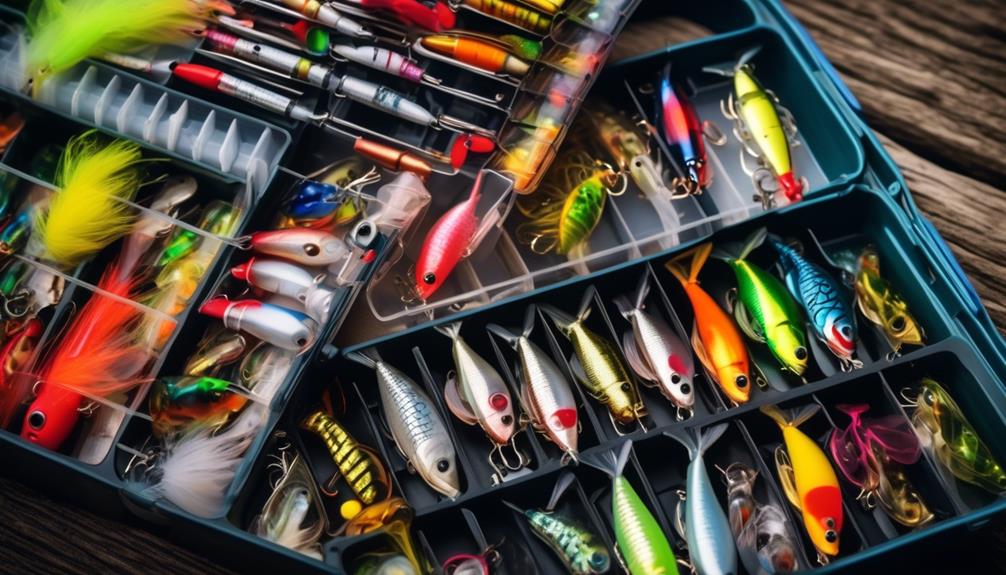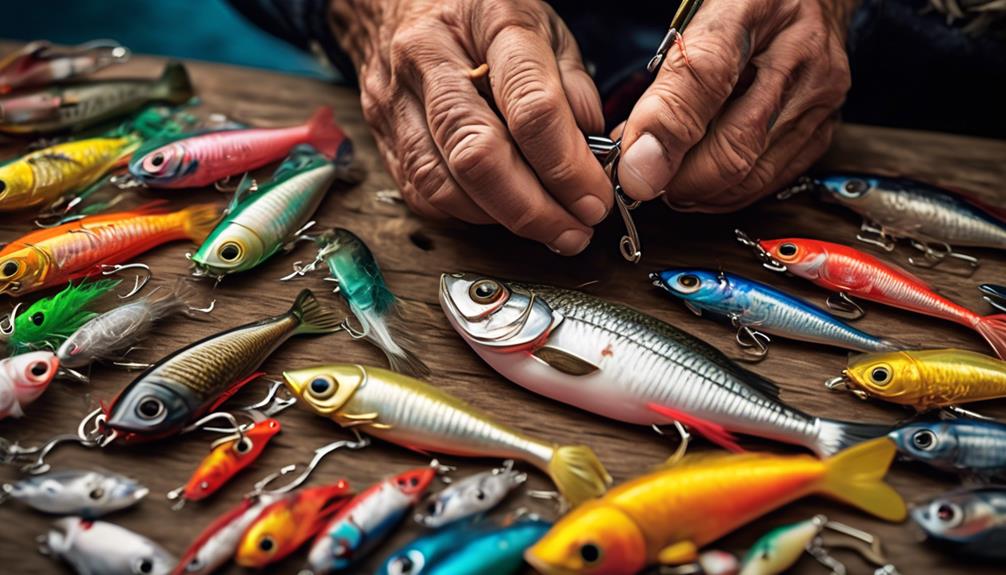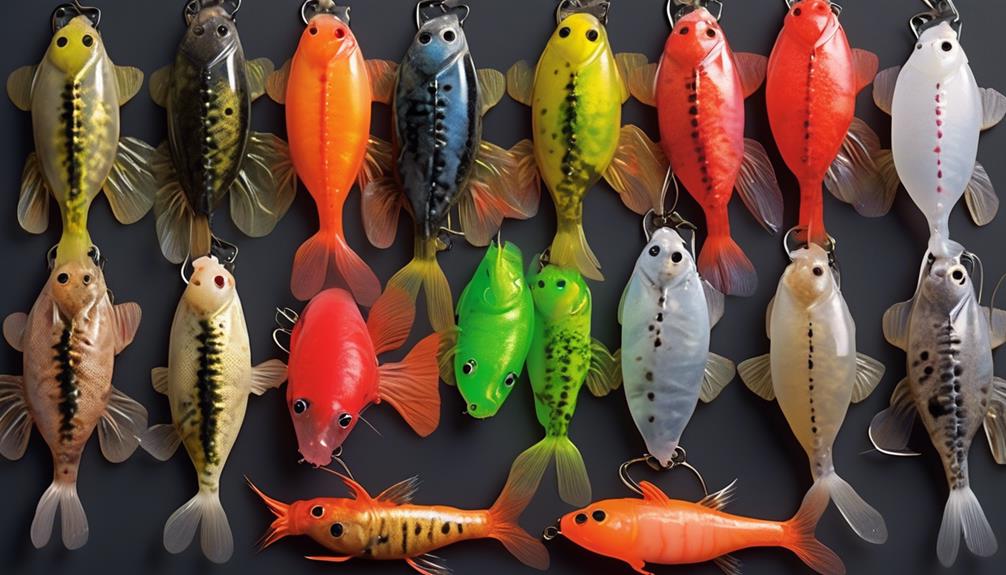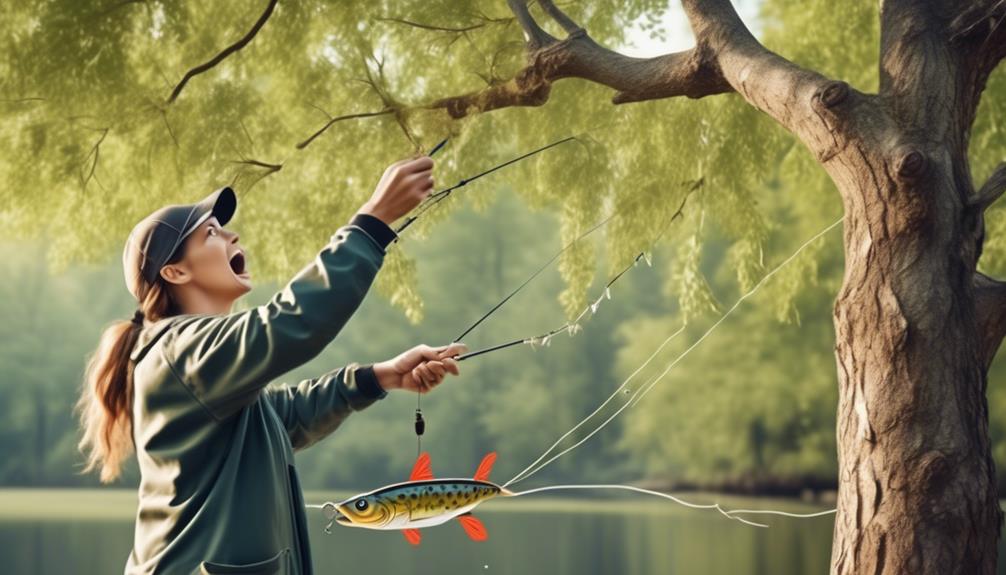Ever wondered why some anglers seem to effortlessly reel in the biggest catches while others struggle? The secret may lie in the art of selecting the perfect fishing bait and lures. With countless options available, it can be overwhelming to determine which ones will entice the fish in your area.
But fear not, as we've compiled 12 expert tips to help you navigate the world of fishing baits and lures. By the end of this, you'll be equipped with the knowledge to make strategic and informed decisions, giving you an edge the next time you head out to the water.
Understand Your Target Fish
To increase your chances of a successful fishing trip, it's essential to understand the behavior and preferences of the fish you're targeting. Researching the behavior and habitat of the fish you want to catch is crucial. Different species of fish have specific preferences when it comes to their habitat. Some prefer clear, shallow waters with plenty of vegetation, while others thrive in deep, murky areas near rocks or fallen trees. By understanding these habitat preferences, you can increase your chances of finding and catching your target fish.
Prey preferences are another crucial factor to consider. Some fish are carnivorous and prefer live bait, while others may be more inclined to bite at artificial lures that mimic their natural prey. Knowing the prey preferences of your target fish will help you choose the most effective bait or lure to attract them.
Feeding patterns also play a significant role in understanding your target fish. Some fish are more active during specific times of the day, while others feed at night. Additionally, understanding whether the fish you're targeting are bottom-dwellers, surface feeders, or mid-water swimmers can guide your choice of bait or lures and how you present them.
Consider Water Conditions
Considering the water conditions is crucial for determining the most suitable fishing bait and lures. To adapt to weather changes, it's essential to understand how the current conditions affect fish behavior and feeding patterns.
Different water conditions, such as clear, murky, or choppy water, can significantly impact the effectiveness of certain baits and lures. When the water is clear, fish can see more details and may be more cautious, so choosing appropriate bait is crucial. In such conditions, natural-looking lures and live baits like worms or minnows are often more effective.
On the other hand, in murky water, where visibility is limited, using brightly colored lures or baits with rattles to create noise can help attract fish.
Furthermore, the depth of the water and its temperature are also important factors to consider when selecting the right bait and lures. For example, in colder water, fish may be less active and more selective in their feeding, so using smaller, slower-moving baits can be more effective. Conversely, in warmer water, fish tend to be more active and aggressive, making larger, faster-moving lures a better choice.
Additionally, if the water is shallow, using topwater lures can be highly effective, while deeper waters may require sinking baits to reach the fish at the right depth.
Know the Local Prey
Understanding the local prey in the area will help you tailor your bait and lure selection to effectively attract the specific fish species you're targeting, based on the prevailing water conditions and temperature. When considering the local ecosystem, take into account the behavior and feeding patterns of the prey in the area. Different fish species have varying preferences for prey, and knowing what they typically feed on can significantly improve your chances of a successful catch.
Research the local prey behavior by observing the feeding habits of the fish species you're targeting. For instance, if the prevalent prey in the area includes smaller fish or insects, you may want to consider using lures that mimic the movement of these creatures. Understanding the local prey can also help you determine the best time of day to fish, as some fish species are more active during specific times when their prey is most abundant.
Moreover, knowing the local prey can guide your choice of bait. If the fish in the area are accustomed to feeding on a specific type of prey, using that as bait can be highly effective. The local ecosystem plays a crucial role in the availability and behavior of the prey, so being attuned to these factors will greatly enhance your fishing experience. By adapting your bait and lures to match the local prey, you can increase your chances of a successful and rewarding fishing trip.
Match Bait to Season
Adjust your bait selection to match the prevalent seasonal conditions for optimal fishing success. Different seasons bring changes in water temperature, weather patterns, and the behavior of fish. Adapting your bait and lure choices accordingly can greatly improve your chances of a successful fishing trip.
During the spring, fish tend to be more active and are often found in shallower waters. This is the time to use natural-looking bait such as worms, insects, or small baitfish to mimic the abundance of food sources available to fish during this season. Topwater lures can also be effective during the spring as fish are more likely to strike at surface-level prey.
As summer arrives and water temperatures rise, fish become more aggressive. This is the perfect time to use fast-moving lures such as spinners, crankbaits, and jigs. Fish tend to move deeper into the water to find cooler temperatures, so adjusting your fishing techniques to include deeper diving lures can yield better results.
In the fall, fish start preparing for the winter by feeding aggressively. Using bait that imitates the local prey's movement and behavior can be highly effective during this time. Additionally, as the weather cools down, fish become more lethargic, so slowing down your fishing technique and using slower presentations can lead to more bites.
During the winter, fish metabolism slows down, and they become less active. Using live bait like minnows can be effective as fish are more likely to go for an easy meal. Additionally, fishing with slower techniques and giving the bait more time to entice a bite can also increase your chances of a successful catch.
Evaluate Lure Types
As you move from matching bait to the seasonal conditions, it's essential to carefully evaluate the types of lures that will best attract and entice the fish you're targeting. When evaluating lure types, consider the following factors to ensure their effectiveness:
- Types of Lures:
- Topwater Lures: These lures float on the water's surface and are effective for attracting fish that feed on the surface, such as bass or pike.
- Spinnerbaits: Spinnerbaits are versatile lures that can be effective in various water conditions and are great for targeting predatory fish like bass and northern pike.
- Soft Plastic Lures: These lures are incredibly versatile and can mimic the movement of live bait, making them effective for a wide range of fish species.
When evaluating lure types, also take into account the materials used and their durability. The materials of the lure can significantly impact its effectiveness and longevity:
- Materials:
- Metal Lures: These lures are durable and provide excellent casting distance. They're effective for targeting species like trout and salmon.
- Plastic Lures: Soft plastic lures are highly effective and come in a variety of shapes and sizes to mimic different types of baitfish. They're durable and can withstand multiple strikes from fish.
Considering the durability of the lures is crucial, especially if you're targeting fish in rough or abrasive environments. By carefully evaluating the types of lures, along with their materials and durability, you can select the most effective ones for your fishing expedition.
Experiment With Colors
When choosing fishing bait and lures, experimenting with different colors can significantly impact your success in attracting fish. Color psychology plays a crucial role in the effectiveness of fishing baits and lures.
Fish are attracted to certain colors based on their visual perception and the way light travels through water. To maximize your chances of catching fish, it's important to understand how color influences visual attraction.
Color psychology suggests that certain colors can evoke specific responses from fish. For example, bright and vibrant colors like red, chartreuse, and orange are often effective in murky or stained water as they stand out and create a strong contrast. On the other hand, natural colors such as green, brown, and black are more suitable for clear water conditions as they blend in with the surroundings, appearing more natural to the fish.
By experimenting with different colors based on the water clarity and light conditions, you can increase your chances of attracting fish.
Visual attraction is another key aspect to consider when choosing lure colors. Fish have the ability to see a wide range of colors, and their visual perception varies based on the species and their natural habitat. Understanding the color vision of the fish species you're targeting can help you select the most appealing lure colors.
Factor in Depth and Speed
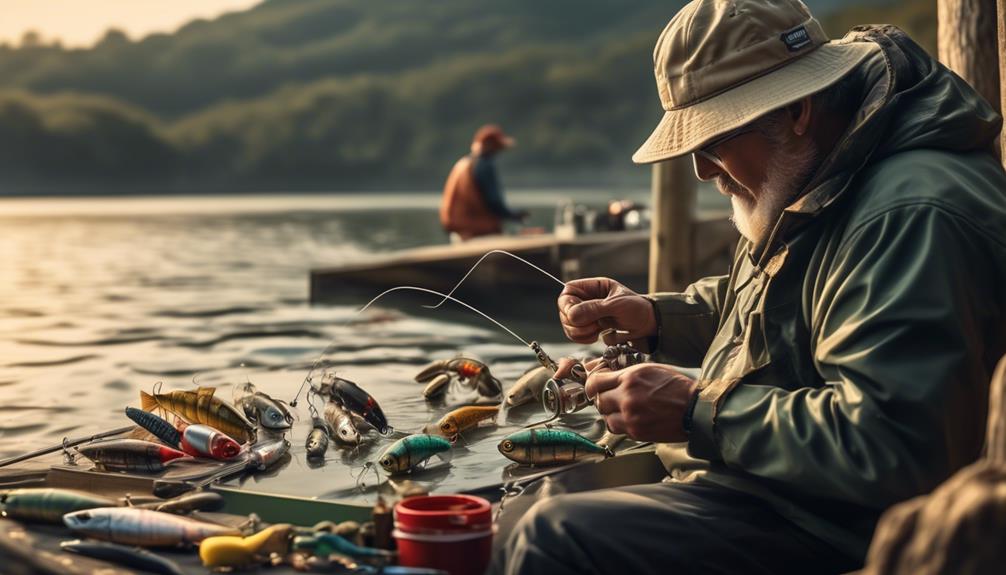
Considering the impact of color psychology and visual attraction on fishing bait and lures, it's essential to factor in the depth and speed of the water to effectively attract fish. The depth variation and speed adjustment are crucial elements that directly impact the success of your fishing endeavors.
Here are some key considerations to keep in mind:
- Depth Variation:
Different fish species prefer varying depths of water. Understanding the specific depth preferences of the fish you're targeting can significantly enhance your chances of a successful catch. Adjust your bait or lures to the appropriate depth for the best results.
Temperature Impact: Depth variations can also influence water temperature. Deeper waters tend to be cooler, while shallow areas may be warmer. Take into account the temperature preferences of the fish you're targeting and adjust your fishing approach accordingly.
- Speed Adjustment:
The speed at which you retrieve your bait or lure can make a significant difference in attracting fish. Some species are more attracted to faster-moving bait, while others prefer a slower, more leisurely approach. Experiment with different retrieval speeds to find what works best in a particular fishing spot.
Current Influence: The strength and direction of the water current can impact how your bait or lure moves through the water. Understanding the current patterns in the area you're fishing can help you adjust your speed and technique for optimal results.
Selecting Natural Vs. Artificial
When selecting bait and lures for fishing, consider the advantages and disadvantages of using natural versus artificial options. Both natural and artificial baits have their own set of benefits and drawbacks, so it's important to understand how they can impact your fishing techniques.
Live bait, such as worms, minnows, or insects, can be highly effective as they closely resemble the natural prey of the fish you're targeting. This can make them particularly appealing to certain species and can result in more bites. Additionally, live bait can give off natural scents and movements that are difficult to replicate with artificial lures. However, using live bait requires additional care and maintenance, and it may not be as convenient to carry around as artificial lures. Furthermore, some anglers have ethical concerns about using live bait, preferring to catch and release fish without harming them.
On the other hand, artificial lures offer a wide variety of options in terms of colors, shapes, and sizes, allowing you to mimic different types of prey and experiment with various fishing techniques. They're also durable and can be reused multiple times, making them a cost-effective choice. However, artificial lures lack the natural scents and movements of live bait, which can sometimes make them less appealing to certain fish species.
Ultimately, the choice between natural and artificial bait comes down to angler preferences, target species, and fishing conditions. It's important to experiment with both options to determine which works best for you in different situations.
Frequently Asked Questions
How Can I Improve My Casting Technique to Effectively Use Different Types of Bait and Lures?
To improve accuracy and casting distance with different bait and lures, focus on your technique. Practice proper wrist snap and smooth acceleration during the cast.
Experiment with different rod actions and lengths to find what suits you best.
Pay attention to wind direction and adjust your casting angle accordingly.
Lastly, try using different types of bait and lures to see which works best for your casting style.
What Are Some Common Mistakes to Avoid When Using Specific Types of Bait and Lures?
When using specific types of bait and lures, common mistakes to avoid include:
- Selecting the wrong bait for the fish you're targeting
- Improper lure presentation
- Using the wrong hook size.
To increase your chances of success, it's important to:
- Research the type of fish you want to catch and choose bait accordingly.
- Pay attention to how you present your lure in the water.
- Match the hook size to the bait you're using.
Are There Any Environmentally Friendly Options for Bait and Lures?
If you're looking for environmentally friendly options for bait and lures, there are some great choices available.
Many companies are now producing eco-friendly options, such as biodegradable baits and lures made from sustainable materials.
Conservation efforts have led to increased awareness and development of these products, allowing you to enjoy fishing while minimizing your impact on the environment.
Check out these options to support conservation efforts and enjoy guilt-free fishing.
How Can I Determine the Best Time of Day to Use Certain Types of Bait and Lures?
To determine the best time for using different types of bait and lures, consider factors like water temperature, weather, and the behavior of the fish you're targeting.
For example, early morning and late afternoon are often optimal times as fish tend to be more active.
Experiment with different baits and lures during these times to see what works best.
What Are Some Alternative Methods for Attracting Fish Besides Using Bait and Lures?
To attract fish without bait and lures, consider fish behavior and natural attractants. Understanding the movement patterns and feeding habits of different fish species can help you find them more effectively.
Additionally, using natural attractants like live bait, fish feed, or insect larvae can draw fish to your location.
Experimenting with these alternative methods can enhance your fishing experience and increase your chances of a successful catch.
Conclusion
So, whether you're fishing in a lake, river, or ocean, remember to consider the type of fish you're targeting, the water conditions, and the local prey.
Match your bait to the season and experiment with different lure types, colors, and depths. Whether you prefer natural or artificial bait, there are plenty of options to choose from.
With these tips in mind, you'll be well-equipped to catch the perfect fish on your next fishing trip. Happy fishing!
